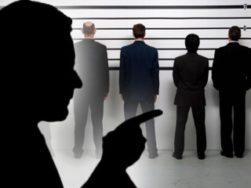Source of article The Jury Room - Keene Trial Consulting.
 We’ve written about eyewitnesses and problems with accuracy here often. Today we have an article that tells us 242 people were wrongly identified by eyewitness testimony and served years in prison prior to being exonerated by DNA testing. Researchers at Florida Atlantic University wondered how memory in people might be altered by police use of “individual mugshots, an array of mugshots, composite sketches, and lineups” as well as subtle innuendos. Specifically, they wanted to answer this question:
We’ve written about eyewitnesses and problems with accuracy here often. Today we have an article that tells us 242 people were wrongly identified by eyewitness testimony and served years in prison prior to being exonerated by DNA testing. Researchers at Florida Atlantic University wondered how memory in people might be altered by police use of “individual mugshots, an array of mugshots, composite sketches, and lineups” as well as subtle innuendos. Specifically, they wanted to answer this question:
Does presenting a picture along with a question like ‘is this the person who did it?’ create an association between those two things that could then cause an eyewitness to later falsely remember seeing that person doing that action?”
The researchers used 80 undergraduates (median age 19 years) and 40 “older adults” (median age 71 years) to test their question. Each participant was shown a series of videos snippets of actors doing simple actions and were then instructed to remember which actor did which task. The researchers created 84 mugshots from these video snippets and also created a series of various scenarios of the events depicted in the video snippets. Each participant was shown two mugshots: one was an actor who’d appeared in the video snippets and the other was a new, random actor (who had not been in the video snippets). They completed this task 36 times (each time choosing either one of the mugshots or neither of the mugshots as the person who had completed each task). They were also asked how confident they were in their identification on each of the 36 individual trials.
As participants looked at the mugshots, they were asked a question like “which of these people did you see watering a plant?”. After the mugshot presentations, the 40 older adults and half of the younger adults (another 40) were tested immediately to see how much they are able to recognize correctly. The remaining (40) younger adult were brought back three weeks later to be tested again. And what did the researchers find? It varied by age.
Both younger and older participants were more likely to falsely recognize events if the actors appearing in those events had also appeared in the mugshots.
For older adults, mugshot viewing meant they experienced a sense of familiarity when they saw the actor performing in the video snippets even if a different action had been asked about when they viewed the mugshots. (The researchers say this likely meant the older adults recognized the familiar face, but were unable to call up the source or reason for their familiarity.)
This finding leads the researchers to hypothesize that the viewing of mugshots itself may make a face seem familiar to the older adult.
Younger adults were more likely to falsely recognize a suspect if the mugshot of the actor was accompanied by a question about the action the actor was now seen performing in the video snippets. (The researchers think this indicates the young adults formed a specific association between the pictured actor and the queried action which caused them to falsely recall the actor performing the queried action.)
This finding leads the researchers to hypothesize that the viewing of the mugshot, when coupled with the question of whether this person committed a certain act, may leave the younger witness overly confident that they saw something they did not actually see.
The researchers indicate this is (yet another) concerning finding for eyewitness testimony. They express concern that this type of false memory can lead to a “high level of confidence, especially in younger eyewitnesses” since they firmly believe they “saw” the suspect committing the crime. And we have other data to say high confidence in an eyewitness is very persuasive to jurors. The researchers suggest strategies for eye-witness testimony also recommended in prior research.
After viewing mugshots, an eyewitness should not be asked for further identifications. For example, if there are multiple eyewitnesses, only some should be exposed to mugshots and the others can make their identification from a lineup.
If there is only one witness, they will likely be asked to identify the perpetrator in the early stages of the crime’s investigation. This means their memory could be contaminated as the investigation continues. Thus, the literature suggests, “other forensic evidence” should be used to support the witness testimony.
From a litigation advocacy perspective, it is in your best interest to carefully examine the process through which eyewitnesses have been led during the investigatory phases. When memory is so very easy to contaminate (and we know eyewitness testimony is notoriously invalid), it is important to consider educating the jurors on eyewitness errors.
The problem is (as mentioned above) that a falsely confident eyewitness can be a compelling factor in jury deliberations. And in at least 242 cases, those confident eyewitnesses were very, very wrong.
Kersten, AW, Earles, JL (2016). Feelings of familiarity and false memory for specific associations resulting from mugshot exposure. Memory and Cognition, 45(1): 93.

